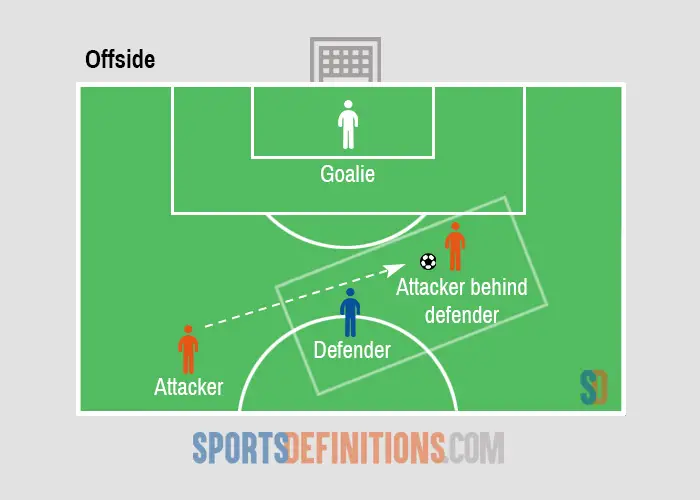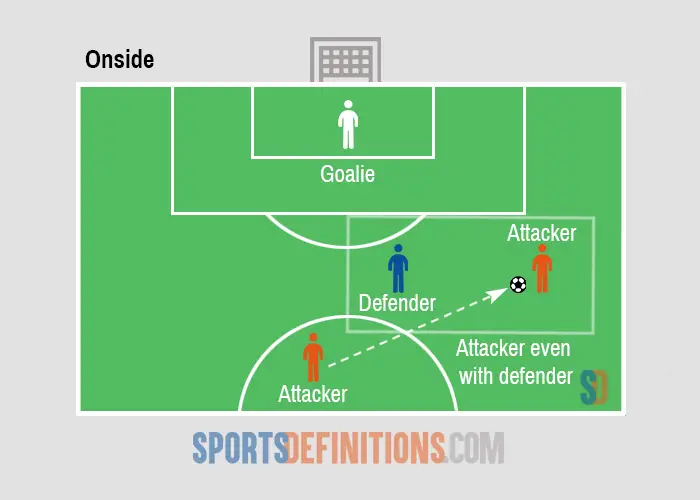What is the Offside Rule in Soccer?
The offside rule in soccer is controversial. There have been many times in important matches when players have scored and then been judged to have been offside. These goals are then disallowed, much to the disappointment of players and fans – especially when the decision is not clear cut.
The offside rule is the 11th law of soccer. At its most basic, the rule dictates that a player is offside when they receive the ball while being in a position beyond the second to the last opponent, who is typically a defender. It is, however, a bit more complicated than this. Read on for an in-depth understanding of the offside rule.
The offside rule explained
In short, a player is considered offside when their teammate plays the ball to them, and they are nearer to the opposing team’s goal than the second to last opposing player (one of which is the goalkeeper) as well as the ball. Unless their teammate plays the ball backwards to them, a player can’t receive the ball and be considered onside unless there are two players level with them or in front, between them and the goal.
Below are diagrams illustrating how a player can be offside or onside.


It is not an offense for a player to be offside. The player must be deemed to be involved in active play to be penalized for being offside. Offside can therefore be called when a player is in the opposing team’s half, is interfering with play, is gaining an advantage by being in that position, or is interfering with an opponent.
If a player is deemed to be interfering with an opponent, it means they are preventing the opponent from defending against the attack. If the player is considered to be interfering with play, in this regard, it means that they are part of the attacking move.
To merely be in the offside position, without it being an offense, a player would have any part of their feet, body, or head in the opponent’s half, and this body part would be closer to the goal line than the ball and second to last opponent. Players’ arms and hands, including the goalkeepers, are not considered in this. The player is not in the offside position if they are level with the second to last opponent.
The key difference within the rule, then, is whether it is offside position or offside offense. Where offside offense is called, the player will be penalized. In these cases, the referee will award an indirect free kick at the point where the violation occurred. That includes offside offenses which occur in a player’s own half of the field.
A player can be in an offside position as frequently as they like during a game without incurring any sanctions providing they are not in active play. However, repeated offside calls can disrupt the game and be frustrating for both players and spectators.
In terms of determining offside decisions, the most crucial moment is when the ball is delivered by the player passing it to their teammate. Before the ball is struck, the receiving player can be in an offside position. However, the moment the ball leaves the passing player’s head or foot, the receiver must ensure they are at least level with the second to last opposing player.
Can you be offside from a goal kick?
No, regardless of what position the player takes on the pitch, it isn’t an offside offense for them to receive the ball directly from a goal kick.
This was established in 1863 when the FA laws were first introduced. The ‘strict’ offside law used at this time actually meant that when taking a goal kick from the goal line, every player on the attacking team would automatically be in offside position.
Can you be offside from a throw-in?
No, if a player receives a ball directly from their own team’s throw-in this is not considered an offside offense.
The FA laws originally set out in 1863 meant that players were unable to be offside from a throw-in, but it would’ve been difficult for a player to gain an advantage by being ahead of the ball as it had to be thrown in at a right angle to the touch-line.
This changed in 1877, as the new throw-in law allowed the ball to be thrown in any direction, but the next year another new rule was implemented that meant that a player could be offside from a throw-in.
But again, this rule changed and was amended in 1920 so that a player couldn’t be offside from a throw-in.
Can you be offside from a corner?
No, regardless of where a player is standing, they cannot be in an offside position if their team-mate whips in a corner.
When corners were first introduced in 1872 they had to be taken from the corner flag. This rule made it impossible for an attacker to be offside, due to the corner flag being on the goal line.
Two years later the rules changed when it was permitted that corners could be taken up to one yard from the corner-flag, making it possible for a player to stand in an offside position from them.
Then, at the 1882 International Football Conference, it was established that players should not be offside from a corner. The next year, this rule was officially written into the Laws of the Game.
Why is the offside rule controversial?
Despite being a long-standing and fundamental rule of soccer, the offside rule is frequently at the center of controversy and debate. That is because some aspects of the offside rule involve subjective judgment rather than being black and white.
When an offside player directly interferes with play, the rule is clear cut, and few issues arise. The referee decides precisely when and how an offside player has interfered with an opponent.
There have been many occasions when goals have been allowed despite the nearby presence of a player in the offside position. That is because those players were deemed not to have interfered. However, these decisions can become controversial when players in the offside position make movements towards the ball and then retreat, for example.
This can be perceived as an attempt to interfere and distract the goalkeeper and defenders, potentially impacting their ability to defend against the attack. On the other hand, some would argue that such moves have no impact on the ability to defend against the attack. It is, therefore, down to personal perception and not clear cut.
In soccer, every goal counts. Because offside decisions can impact the results of a match, the rule will likely remain a controversial one unless or until more explicit guidance is issued.
Why did the offside rule come into soccer?
In the early days of soccer, it was common for players to hang around the goal opportunistically. That was known as ‘goal hanging,’ and the offside rule was created to prevent it.
The offside rule was first created in 1863 but has evolved since then. The earliest version of the offside rule stated that a player was offside if there were fewer than three opposing players, including the goalkeeper, in front of him.
The first change to the offside rule came about in 1925. From this point on, a player would be offside when there were fewer than two opposing players, including the goalkeeper, in front of him.
In 1990, the offside rule was changed again. This change dictated that a player could be considered onside when they are level with the second to last opposing player, usually a defender. They should still have another player in front of them, which would typically be the goalkeeper.
The implications of VAR on offside accuracy
The VAR (Video Assistant Referee) can help the head referee on the pitch to determine offside decisions where it is a tough call. The VAR reviews the head referee’s decisions through the use of video footage technology. They also use a headset for communication.
VAR is a relatively new addition to competitive soccer, which officially became part of the Laws of the Game in 2018. This followed extensive trials in numerous major competitions. The VAR system is intended to minimize human errors which influence the results in soccer matches. The philosophy behind VAR is that of ‘minimal interference, maximum benefit.’ It is designed for use in cases of missed or contested incidents or where the head referee is unsure.
The VAR system is often used in offside offense cases due to the controversial nature of the offside rule and because these decisions are sometimes difficult to call.
The first task of the VAR is to find the point at which the ball was kicked or headed by the passing player because this is the moment offside is judged. Once the VAR has determined this frame in the video footage, they can then check whether the attacking player is offside or onside.
In the English Premier League, for example, the VAR determines offside decisions using Hawk-Eye’s virtual offside line technology. This has two components: the gridline and the crosshair. The gridline is a two-dimensional line that can be positioned in line with the final opposing player. Think of the technology used in soccer highlight shows on TV to illustrate what the pundits are talking about – it’s very similar to this.
The crosshair refers to two lines that are positioned for the attacker and the defender. The offside lines are drawn against potential goal-scoring parts of the body of both the attacking and defending players. A three-dimensional vertical line can be used to account for body parts that are off the ground. The crosshair positioning is manual to allow for accurate positioning.
In the Premier League, the process is displayed to broadcasters. That allows fans to see how a decision is reached in real-time.
Many cameras are placed at various angles to capture footage used by VAR’s in reaching offside decisions. This makes VAR decisions potentially more accurate than traditional methods because it is not always possible for referees and assistant referees to view all body parts from the angle they are viewing from.
Another reason why offside decisions can be more accurate with the use of the VAR system is that the video footage allows for replay of moments that happen instantly and can, therefore, be missed or subject to human error.
One thing that the VAR system cannot overcome, however, is the subjective nature of certain offside decisions (see the previous section on why the offside rule is controversial). However, it could be argued that the addition of another referee to the decision-making process ensures a fairer outcome.
Conclusion
The basic offside rule in soccer is fairly straightforward in itself. However, it is controversial because it requires subjective decisions in certain situations when the decision is not clear cut. While the VAR system goes some way towards ensuring greater accuracy in offside decision making, there arguably needs to be further official guidance in this regard.
